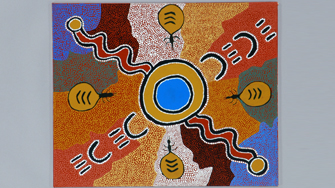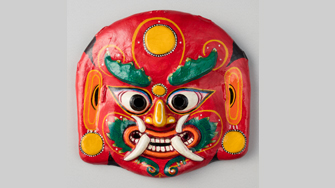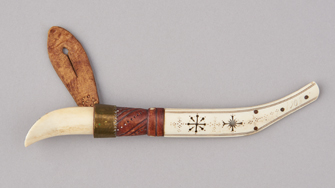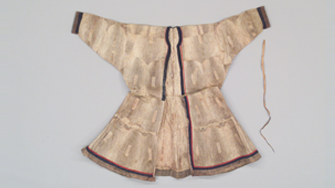Treasures of Indigenous Peoples|Exhibition Concept




Pride, Traditions, and Hopes as Indigenous Peoples
Today, approximately 370 million indigenous people live in more than 70 countries around the world. There are a minimum of 5,000 ethnic groups. The treasures of this special exhibition encompass the heart and soul or the ethnic pride of indigenous peoples, who have been living under oppression or discrimination without losing hope. Minpaku provides a glimpse into the world of indigenous peoples through approximately 740 exhibits of their treasures.
|
Explainer video "General" (Nobuta Toshihiro) [in Japanese] |
The ancestors of the Aboriginal Australians, the Australian Indigenous Peoples, arrived in Australia around 50,000 years ago, but Aboriginal societies and cultures have changed dramatically since the late eighteenth century, when Australia became a British colony. In the Central Desert Region and tropical areas of the Northern Territory, where settler populations are sparse, ways of life based on “the Dreaming,” cosmology and the genesis of the world conducted by the spiritual and ancestral beings, have been preserved. Aboriginal performing and figurative arts are based on the Dreaming. Ceremonies involve communication with the spiritual beings who appear in The Dreaming. The Dreaming continues to be a vital element in Aboriginal identity today.
Kubo Masatoshi (Professor Emeritus)

Aboriginal (Australia) Acrylic painting _H0149428
The Orang Asli live in the dense vegetation of the tropical rain forest. They listen carefully for signs of animals, birdsongs, the sounds of insects, and the whispering of the trees. They are awed not only by living things but everything in nature and believe that spirits lodge in all things. The spirits who guide and protect them warn them of human weakness. Other spirits are dangerous, even life-threatening, and punish human stupidity. Here we introduce the world of the spirits of this people who live with nature.
Nobuta Toshihiro (Professor)
Explainer video "Orang Asli (Malaysia)" (Nobuta Toshihiro) [in Japanese]
There are peoples in Taiwan whose ancestors arrived in Taiwan earlier than the Taiwanese and other Han Chinese who make up the majority population. Called Yuanzhumin (original inhabitants), these Indigenous Peoples are currently divided into 16 groups based on language, social structure, customs, cultural characteristics and identity. Among them, the Tao, who live on Lanyu Island in the Pacific Ocean, are the only group who live outside the main island of Taiwan. Their traditional subsistence are fishing and root agriculture (taro and sweet potato).
Nobayashi Atsushi (Professor)
Explainer video "Tao (Taiwan)" (Nobayashi Atsushi) [in Japanese]
In Nepal, Indigenous Peoples are called Adibasi (first inhabitants). This term refers not only to 59 ethnic groups officially recognized by the government but also to several ethnic groups not officially recognized. The total population of these ethnic groups (Janajati) is approximately 9.49 million, a substantial 36 percent of Nepal’s total population of 26.49 million (2011). Since, however, the ethnic groups are strongly attached to their own languages and original costumes, songs and dances, oral traditions and beliefs, “Indigenous People” is no more than a category created by the Indigenous Peoples movement and confined to its activities. Here we introduce the current situation of the Indigenous Peoples of Nepal, using “ethnic groups” and “Indigenous People” interchangeably as seems appropriate.
Minami Makito (Associate Professor)

Newar (Nepal) Masked Rake_Private Collection
The Maya who live in Guatemala are an Indigenous People with a fourthousand-year history, since the formation of the Mayan civilization. Their history includes many changes, among them the collapse of the Classic Mayan civilization, the Spanish conquest, and Christian evangelization. The act of weaving cloth, however, has remained virtually unchanged. In this exhibit we introduce the variety of huipil (tunic-style garments made from handwoven cloth) worn by contemporary Mayan women and changes that occurred in its designs during the twentieth century. Particularly we pay attention to recent movements to protect Mayan women’s intellectual property rights in traditional designs against piracy and plagiarism.
Suzuki Motoi (Professor)
Honya Yuko (Professor, Keio University)
Explainer video "Maya (Guatemala)" (Suzuki Motoi) [in Japanese]
The San and Somali are well-known African peoples. Both have appeared in movies, the San in ‘The Gods Must Be Crazy’ (1980), the Somali in ‘Desert Flower’ (2009), ‘Captain Phillips’ (2013). When we imagine the San, we see hunters-and-gatherers. The Somali we see as pirates. But are these images true? Having done fieldwork in both of these societies, I would like to introduce more realistic images of both. Should we see them as Indigenous Peoples? Let’s see what their histories and cultures teach us.
Ikeya Kazunobu (Professor)
Explainer video "Sun, Somali (Africa)" (Ikeya Kazunobu) [in Japanese]
Canada is known as a nation of immigrants, but there are also numerous Indigenous Peoples, each with its own culture, whose ancestors moved to North America long before Europeans began arriving at the end of the fifteenth century. Particularly eye-catching examples are the Haida, Kwakwaka’wakw, and Tsimshian. Because of their similar cultures, they are grouped together as Northwest Coast Peoples. Here we introduce masks, ritual implements, and prints as examples of these cultures.
Kishigami Nobuhiro (Professor)
Explainer video "Northwest Coast People (Canada)" (Kishigami Nobuhiro) [in Japanese]
Formerly called Lapps, the Sami are known as reindeer herders and seen thrown the lens of a pastoral image. Their history, like those other Indigenous Peoples around the world, is one of having their land encroached on by multiple nations and suffering discrimination. Today, however, the Sami have overcome division by national boundaries and have been granted many rights and cultural autonomy as one nation. In this corner we offer a glimpse of the Sami way of life through the knives that are both indispensable to them in everyday life and symbols of ethnic identity.
Sápmelaččaid leat láven guhká gohčodit namahusain “Lapps” eaŋgalsgillii ja sin leat ádden badjeolmmožin báimmangovahallamiin. Sin historja lea joksege seammá go máilmmi eará álgoálbmogiin, geat leat šaddan gillámušaide, go sin eatnamiidda leat vieris riikkat bahkken. Muhto dál leat sápmelaččat ovttastuvvan oktan álbmogin badjel stáhtarájáid, ja sii leat vuoitán sihke máŋggalágan mearkkašahtti rivttiid ja kultuvraautonomiija. Dán ossodagas mii geahččat sápmelaččaid eallinvuogi sámeniibbiid bokte. Dákkár niibbit leat vealtameahttumat sidjiide juohke beaivve ja maiddái etnihkalaš symbolan.
Shoji Hiroshi (Professor Emeritus)
Rossella Ragazzi (Visual Anthropologist; Associate Professor, Tromsø University Museum)

Knife (Sweden) _H0078296
The Ainu have lived in Hokkaido, Karafuto (Sakhalin), the Kuril Islands, and the northern part of the Tohoku in Honshu (mainland Japan), but now they primarily reside in Hokkaido. They developed own culture, including Ainu language. Then, as assimilation proceeded during the Meiji era, they were forced to make major changes in their way of life. From 1905 to 1945, when southern Sakhalin was Japanese territory, the Uilta and Nivkh peoples who live there were also largely Japanized. In this exhibit, we display the original prints for manga Golden Kamuy which is set about one hundred years ago, traditional artifacts, and works by contemporary artists and artisans. We introduce what Ainu treasured and the legacies they inherited and created for their descendants.
Saito Reiko (Associate Professor)

Ainu (Sakhalin) _fish skin clothing_K0004613

© Written by Noda Satoru/SHUEISHA
Along with the gem of the original digital drawings of the Golden Kamuy (Written by Noda Satoru), the Ainu folk crafts that appear in the works will be exhibited. Set in Hokkaido in the late Meiji period, “Golden Kamuy” is an adventurous action film in which Sugimoto Saichi, a veteran of the Russo-Japanese War, and the Ainu girl Asirpa engage in fierce competition for the legendary gold ingots with the remnants of the Seventh Division of the Japanese Army and Shinsengumi.
It is a popular work that is being serialized with good reviews in 'Weekly Young Jump' (SHUEISHA), and it was made into an animation in 2018, and the first and second stages were on air, and the production of the third stage was decided.





